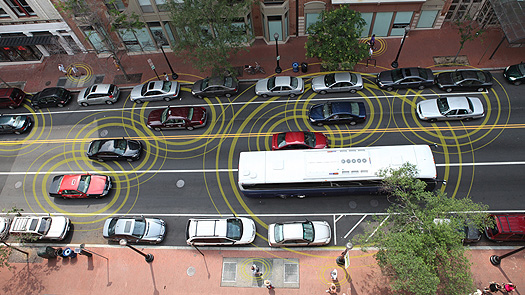Before beginning today’s posting describing the rise of wireless vehicle networks I want to remember James Martin, futurist, telecommunications guru, and prolific author (104 books) who I had the pleasure of meeting when I worked in the publishing industry back in the 1970s. He was an intellectual force with brilliant insights into what the future would bring. I had written a blog posting commenting on a book he published last year called The Meaning of the 21st Century, in which he posed 16 challenges humanity faces. If you haven’t had the opportunity to read it you can get a sample at the following link.
Dr. Martin would have liked the subject of today’s posting. It is something he anticipated through the convergence of artificial intelligence, wireless telecommunications and cars. The terminology describes all of this as vehicle-to-vehicle communication. But it is more than that. In the age of the Internet of Things, not just vehicles can talk to each other. So can the roads, signs and other transportation infrastructure get involved in the conversation. What this inevitably means is higher degrees of safety, less use of fossil fuels, and less polluting carbon.
Rsearch is being done at UMTRI short for University of Michigan Transportation Research Institute. Its goal is summed up by Director Peter Sweatman who states:
“Integrating the most promising approaches to mobility into a coordinated system could reduce motor vehicle fatalities and injuries as well as energy consumption and carbon emissions by as much as a factor of ten….we also estimate that freight transportation costs could be cut by a factor of three, and the need for parking could go down by a factor of three.”
To achieve these welcome results UMTRI in cooperation with the U.S. Department of Transportation is conducting the largest real-world experiment involving vehicle-to-vehicle communication in Ann Arbor, Michigan. This is ongoing right now and involves ordinary drivers who have lent 2,800 vehicles to the project, a mix of cars, trucks, buses, motorcycles and bicycles. All have been fitted with short-range transmitters and receivers that can broadcast a signal approximately 300 meters (1,000 feet). The connection is through specialized Wi-Fi operating at 5.9-Gigahertz on a network designed specifically for vehicles on the move. Not all the vehicles in the test are outfitted equally. Some just broadcast information to other vehicles in the moving network. Others though will receive warnings based on what is happening to cars and other vehicles in their immediate vicinity. For example, if a car a few vehicles ahead suddenly brakes, a car that receives warnings will see a dashboard alert appear.
This type of vehicle-to-vehicle information sharing has enormous implications. Internetworked cars can eliminate transportation bottlenecks by adjusting speeds to optimize traffic flow. Internetworked cars can anticipate and avoid collisions. And optimizing vehicle flow can reduce carbon emissions and fuel consumption, both highly desirable outcomes. The first results will be published in August of this year.
UMTRI is not alone in developing a standard for vehicle-to-vehicle communication. Google has been experimenting with autonomous vehicles that interact without human intervention. And in Europe, Car2Car represents an attempt to create an open standard for internetworking the transportation infrastructure. Add to this mix smart highways such as those being developed in the Netherlands and you have a formula for greater vehicle safety, energy savings and reduced polluting greenhouse gases. It’s hard not to want to jump on this bandwagon. I think Dr. Martin would have approved.
















